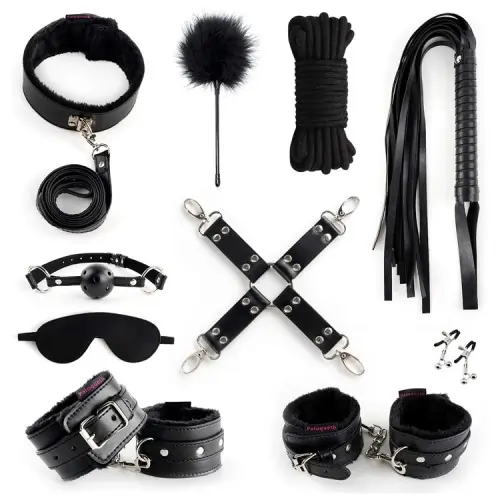Whats BDSM (Bondage & Fetish)

Dominant Types According to the BDSM
Over the course of the past decade, there have been a number of noteworthy modifications in the manner in which society regards BDSM and bondage play. What was formerly considered scandalous and risqué is now dangerously close to being accepted by the general public. Discussions of what BDSM is/can be/might look like are becoming more sophisticated as a result of the increased number of people than ever before who are exploring all of the shades of grey. To summarise, there are a wide variety of approaches to achieving a kinky state. There is always more to learn, even for those who already have a good understanding of the fundamentals. It’s possible for two people to identify themselves as dominating but have quite different conceptions of what that label actually entails. Today, exactly that topic is being discussed in our group! We will discuss dominants, including what it means to be a dominant, the various sorts of dominants that exist, and what you need to know in order to participate in BDSM play that is both safe and rewarding. Continue reading to learn more about the five different sorts of dominants that BDSM recognises.
WHAT IS BDSM, EXACTLY?
Before we get too far into discussing this matter, we need to be sure that everyone has the same understanding of what’s going on. Just what is the BDSM? This abbreviation is generally applied to sexual actions and behaviours that involve pain, power exchange, or physical restriction of some kind. Bondage, Discipline (or Dominance), Sadism (or Submission), and Masochism are the four concepts that are represented by the letters BDSM. The terms “kink” and “BDSM” cannot be used interchangeably. In general, behaviours associated with BDSM are referred to as “kinky,” however not everything that is kinky is BDSM.
FACT ABOUT BDSM That Might Take You by Surprise
Some of the characteristics of BDSM, particularly for those who are new to it, can be quite startling. This is typically the case because individuals come to the discussion with a variety of preconceived beliefs (such as the dominant partner having complete control, submission being inherently feminine, BDSM being harmful or unhealthy, and BDSM being scary) that do not necessarily align with reality. Since you are reading this essay, you will, thankfully, be aware of the facts and prepared to participate in BDSM play in a way that is both safe and beneficial to your health. The following are some unexpected facts about BDSM:
There is no correlation between gender or sexual orientation and BDSM roles. Some individuals fall prey to the misconception that submitting is inherently “feminine,” and that no self-respecting male would ever choose to act in such a manner. Incorrect! Any individual, regardless of their gender or sexual orientation, is capable of playing any role.
You are not going to perform it in a “incorrect” manner. You could do it wrong if you decided that you did not care about consent or safety, but as long as you are aware of those things, you and your partners get to pick what you love doing together. Okay, so you could do it wrong if you decided that you did not care about consent or safety. There is not a one “correct” approach to BDSM. It’s possible that some people will try to convince you that you aren’t truly a dom or a sub if you don’t do certain things or if you don’t do things in a specific way, but as long as everyone is happy and safe, you have the ability to select your own rules and methods that BDSM will work for you.
The RACK system is a safety mechanism. Let’s talk about RACK while we’re on the subject of engaging in a responsible and risk-free manner. The term “Risk-Aware Consensual Kink” might sound like something you’d use to bind someone in a BDSM scenario, but in reality, it’s just an abbreviation that stands for “risk aware consentual kink.” The most important thing you can do to protect yourself while playing BDSM is to be aware of the dangers posed by any practises you partake in. This enables you to take measures to reduce that risk and ensure the safety of everyone involved. In addition, we are well aware that permission is of the utmost importance; nevertheless, if a person agrees to try something without being fully informed of the potential consequences, can we consider their consent to be genuine? In no way do I believe that to be the case. RACK is a tool that helps ensure that everyone knows exactly what they are getting themselves into and can collaborate with one another to try to keep things safe.
The word “forced” does not actually mean what it says. BDSM can involve a number of things that, to an outsider looking in, might seem embarrassing or frightening; nevertheless, the most essential thing to bear in mind is that everything is pre-negotiated and voluntary on the part of the participant. So, for instance, a “forced” orgasm scene in which the dominant participant restrains the submissive one and forces them to orgasm against their will is actually something the submissive partner has agreed to. In this scenario, the dominant person is the one who has the power. It is very likely that there will be a safe word that may be used to halt the activity if someone is feeling uncomfortable or if something goes wrong. It is not the purpose of BDSM to truly coerce individuals into doing things that they sincerely do not want to do. A dominating partner who doesn’t respect that or claims to not utilise safe phrases (people like this do exist) is usually more interested in exerting power over someone than in engaging in mutually happy BDSM play.
Nobody ever entirely relinquishes their control. To expand on the previous point, it may appear as though a submissive is powerless and at the mercy of their dominant, but BDSM is an exchange of power, which means that the submissive is agreeing to the power dynamics. This is despite the fact that it may give the appearance that the submissive is powerless. This calls for respect and trust on the part of the dominant, both of which must be acquired through time. To summarise, rather than being powerless, submissives actually hold the power in the relationship.
You really ought to enjoy yourself! Taking BDSM much too seriously is one of the most common mistakes people make when attempting to implement the methodology. Do not fall into the trap of thinking that doing BDSM “right” means being the most serious Dom in the history of domination just because you want to be serious about boundaries, consent, and safety (as you would in any scenario). Yes, you want to be serious about boundaries, consent, and safety (as you would in any scenario). There is a reason why BDSM practitioners term to the practise as “play.” Have fun!
BDSM ROLES BDSM has a full lexicon to it, so let’s take a minute to clarify a couple of the basic terminology! Here are some of the roles that you can play in BDSM!
Dominant
As a general rule, the person who is in charge of a BDSM scene is referred to as the dominant. We’ll go into more detail on this topic in a moment. It’s possible that you consider of the Dominant as being “in charge,” but keep in mind that BDSM play is collaborative, and agreement is needed for each phase.
Submissive
One who allows themselves to be controlled by another person in a relationship is known as a submissive. It’s possible that different people and different relationships have different interpretations of what it means to be submissive. The ability to derive pleasure from whatever activities they and their dominant choose to partake in together, as well as the habit of trying to please their dominant, is the primary trait that all submissives have.
Switch
A switch is a person who is able to move between the positions of being dominant and submissive because they are comfortable in both of these roles.
While for some people these roles are only played out in the bedroom, others participate in what is known as TPE, which stands for total power exchange. Within the context of TPE, the dominant partner is the one who is in charge of making all of the decisions on behalf of the submissive partner. If the submissive partner challenges the dominant in any manner, they risk being punished (in accordance with an agreement that was reached beforehand). The submissive partner is expected to comply to do what they are instructed without making any arguments. However, many people use the phrase to refer to relationships in which the Total Power Exchange is more of a lifestyle choice. Although TPE can be exclusively exercised during play time in the context of BDSM “scenes,” many people use the term to apply to such partnerships. As an illustration, a submitting partner will dress, cook, clean, and behave in accordance with the directives of the dominating partner.
WHAT Is Considered to Be a Dominant in the BDSM?
Let’s get into dominants now that we have a basic understanding of the BDSM’s nuts and bolts, shall we? According to the BDSM, the partner who rules (or dominates) another partner in a consenting manner is referred to as the Dominant. A relationship in which one person is dominating and the other is submissive is frequently referred to as a D/s relationship. A dominant person usually takes leadership of the situation and ensures that all actions are carried out in a manner that is safe and to the satisfaction of everyone concerned. In addition, once the scene is over, a dominant will provide their submissive with aftercare that they have prepared for them.
We touched on this topic a little bit previously, but it’s vital to keep in mind that dominants are a part of a scenario of consensual play that is arranged in advance. This is something that needs to be remembered. Being dominant in a relationship does not mean that you get your way no matter what or that your partner cannot say no to you. People will occasionally talk about how they are dominant and how they will provide aftercare to their subordinate once the action is over. Occasionally, you will witness people doing this.
We touched on this topic a little bit previously, but it’s vital to keep in mind that dominants are a part of a scenario of consensual play that is arranged in advance. This is something that needs to be remembered. Being dominant in a relationship does not mean that you get your way no matter what or that your partner cannot say no to you. People will occasionally boast about the fact that they are a “genuine” Dom or Domme, including information such as the fact that they don’t “believe in safewords” or other information that indicates they do not intend to take part in an intimate relationship that is both safe and fair. Stay away from these individuals, and under no circumstances should you adopt their mannerisms. Being dominant does not entail being domineering, and a dominant partner should exercise their authority for the benefit of their submissive rather than simply because they like the feeling of having power over someone else.
TYPES OF DOMINANTS IN BDSM
Today, we are going to take a look at four of the many different ways that one can be the dominating partner in a relationship. It’s okay if none of these descriptions fit you quite like a glove. These are but a few of the many possible manifestations of dominance.
Top
The “top,” the dominant equivalent of the submissive “bottom,” represents the more laid-back extreme of the dominating spectrum. Tops are frequently referred to as “bedroom dominants” since they are the only characters in a scene that can take on the dominant or active role. In addition, there are Service Tops who might not be actively domineering, but who choose to play an active role in BDSM scenes because they take pleasure in serving their partners. A top will give aftercare for their partner, in addition to possibly spanking or binding them.
Master/Mistress
Anyone involved in a D/s relationship is free to use these titles (remember, you get to pick what your BDSM looks like!). However, they are more usually used as the counterpart to “Master” in a Total Power Exchange, which refers to the kind of 24/7 D/s connection that we discussed earlier. In this scenario, a Master or Mistress would hold authority over many, if not all elements of their Slave’s life in accordance with the terms of their contract. This control would be exercised in a manner that was specified by the contract. They might allow their Slave to eat, speak, use the bathroom, and other similar activities, but they would also administer discipline to their Slave if they misbehaved. It is essential to keep in mind that in this kind of relationship, either the Master or the Mistress will often be the one to assume responsibility for their partner’s health.
A Master of Containment
In order for you to comprehend this one, you need to be aware that a Brat is a type of submissive that has a propensity to be sassy and naughty, and who may misbehave on purpose in order to provoke their dominant spouse into disciplining them. Brat tamers have a tendency to find the defiant behaviour of a brat to be either amusing or endearing, and they are strong and patient enough to earn the brat’s submission while remaining respectful enough to make the brat feel secure and cared for. Brats tend to find that brat tamers find their defiance to be either amusing or endearing.
Daddy or Mommy
Do you want to take care of someone while simultaneously maintaining your authority over them? If this describes you, then becoming a parent might be the perfect fit for you. This style of control generally entails being loving toward a subordinate and taking their health and wellbeing seriously. A Daddy or Mommy dominating may use scolding or spanking as a form of discipline, but they may also provide reassurance, protection, and praise. These dominant types work nicely with submissives who are Good Girls or Good Boys.
Owner
Pet play is a common pastime in BDSM, in which participants take on the role of cats, dogs, horses, or virtually any other animal they like. However, these pets require owners. The owner may choose to place a collar on their animal companion, hand-feed it, groom it, touch it, or engage in any other activity that they deem suitable for their pet. Pet play provides dominants with a wealth of enjoyable opportunities to play with sex toys and accessories such as collars, leashes, muzzles, bridles, crops, and many more. This is a distinct advantage of the activity.
Are you prepared to assert your authority? Do you intend to play a tease game with your submissive and want to stock up on bondage toys? Or, are you perhaps interested in some steamy bondage clothing? Whatever it is that you’re looking for, you may get it at adultsextoysindia.com. They provide everything from the toys and accessories to the impact gear, restraints, and bondage kits that you require to take your BDSM to the next level.



